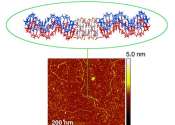DNA nanorobots find and tag cellular targets
Researchers at Columbia University Medical Center, working with their collaborators at the Hospital for Special Surgery, have created a fleet of molecular "robots" that can home in on specific human cells and mark them for ...





